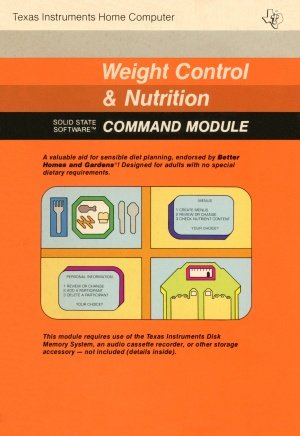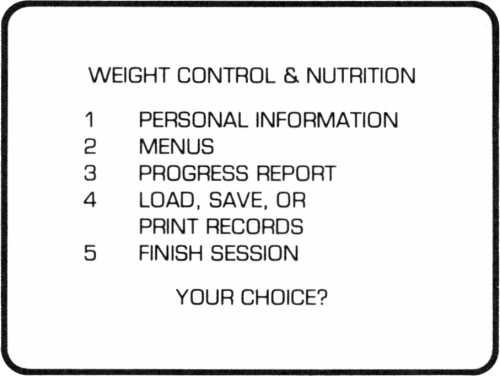Weight Control & Nutrition
| Weight Control & Nutrition | |
|---|---|
 Weight Control & Nutrition Manual (Front Cover) [1] | |
| Publisher(s) | Milton Bradley |
| Original Retail Price | $59.95 (USD) |
| Part# | PHM 3021 |
| Format(s) | Solid State SoftwareTM Command Module |
| Release | 1981 (1st Quarter) |
| Genre(s) | Nutrition |
Advertising Blurbs
Front Cover of Manual
A valuable aid for sensible diet planning, endorsed by Better Homes and Gardens®! Designed for adults with no special dietary requirements.
Back Cover of Manual
We're all aware of the importance of a good diet. Yet how can we find time in our busy schedules to plan well-balanced meals?
The Weight Control & Nutrition module helps take the guesswork out of planning nutritious meals. Simply enter your personal information and select the foods you want to include in the meals. The computer then creates menus based on the essential nutritional requirements of average adults (age 18 and over). As with any dietary program, you should check with your doctor to make sure the program meets your needs.
Weight Control & Nutrition module features let you:
- ■ Determine your recommended weight range
- ■ Choose a target weight goal
- ■ Create weekly menus based on your weight goal and nutritional needs
- ■ View a nutritional analysis of the menus
The module was developed in cooperation with the staff of Better Homes and Gardens® and features 62 kitchen-tested Better Homes and Gardens® recipes.
Triton Catalog - Spring 1984
Plan balanced meals and improve fitness through nutrition! Your input determines recommended weight range and creates weekly menus tailored to your food preferences and target weight. Menus meet U.S. Recommended Daily Allowances for Adults. (Cassette or Disk Data storage system recommended.)
Manual
About This Program
The Weight Control & Nutrition module is designed to be flexible and easy to use. First, enter personal information about each participant. Up to five people at a time can participate. The computer suggests recommended weight ranges for each person and allows him or her to select a target weight goal. Then, using the selected weight goal, the computer calculates the daily number of calories required in each person's diet.
Once the personal information is entered, you may choose the foods to be included in the menus. Foods may be selected for each person or for the family as a whole. That's all there is to it! You're ready to create a week of menus for an individual or for the entire family!
The Weight Control & Nutrition module is based on widely accepted concepts and research in the areas of nutrition and human physiology. The module program was developed with the assistance of Angela Boren, M.S., R.D., associate professor in the Food and Nutrition Department of Texas Tech University, and Linda Douglas, M.S., R.D., director of the Dietetics Clinic at Texas Tech University Health Sciences Center. The concepts on which the program is based are briefly discussed in the rest of this section.
Proteins, Carbohydrates and Fats
Proteins, carbohydrates, and fats (saturated and unsaturated) are the basic energy-producing nutrients. All food contains at least one of these nutrients, and all three should be included in your daily diet. Based on the Dietary Goals for the United States, developed by the Senate Select Committee on Nutrition and Human Needs, the following proportion for these nutrients is suggested for the average person's daily diet:
| Protein | 15% | |
| Carbohydrates | 55% | |
| Fats, | Saturated | 10% |
| Unsaturated | 20% |
The daily menus created by the Weight Control & Nutrition module include proteins, carbohydrates, and fats in approximately the proportions listed above.
Vitamins and Minerals
Your body requires a wide variety of vitamins and minerals for good health. The Weight Control & Nutrition module takes the following essential vitamins and minerals into consideration when creating menus: vitamin A, vitamin C, niacin, riboflavin, thiamin, iron, and calcium. For each day's menus, the module selects foods which supply these vitamins and minerals approximately in the amounts recommended by the 1980 U.S. RDA (Recommended Dietary Allowance) for adults age 18 and over. The module also provides a nutrient analysis which estimates how closely each day's menus meet the RDA for the above nutrients.
Note that the Weight Control & Nutrition module does not take into consideration all the nutrients needed by the human body. However, it does assign a higher "Food Type" rating to those foods which have a better nutrient content. This procedure, which is discussed below, increases the probability that the menus created by the module supply many of the nutrients you need in your diet.
Nutritional Content of Food
Up to 197 foods can be included in the weekly menus, depending on your food selections. The module assigns each portion of food with a specific nutrient content, using averages compiled by the U.S. Department of Agriculture (USDA).
Each food is also assigned a "Food Type" rating of 1 (high), 2 (middle), or 3 (low). Foods with a higher rating have a better overall nutrient content than do foods with a lower rating. Therefore, when the module is creating menus, it selects Type 1 foods more frequently than Type 2, and Type 2 foods more frequently than Type 3.
The nutrient averages for each food are listed in Appendix B.
Basic Food Groups
The basic food groups are dairy products, breads and cereals, fruits and vegetables, and meat and meat alternatives. According to the USDA, a balanced diet includes daily portions from each of these groups. The menus created by the Weight Control & Nutrition module are based on this concept.
Calories and Body Weight
The module also takes into consideration the relationship between your age, weight, height, and daily calorie requirement.
Calories are units of food energy - the "fuel" your body obtains from the food you eat. According to the USDA and many other authorities, if you take in more calories than you need, the excess energy is stored as fat. Continued overeating thus leads to weight gain, while undereating leads to weight loss. Your weight stays about the same when your calorie intake matches your body's energy needs.
The Weight Control & Nutrition module helps you determine your weight range using a method suggested by the Food and Nutrition Board of the National Academy of Sciences. Three possible weight ranges are suggested for each participant - one for persons with a slim build, another for persons with an average build, and a third for persons with a stocky build. The participant selects a target weight goal based on this information.
To determine your daily calorie requirement, the module first calculates your basal metabolic rate (BMR), using a method developed by Boothby, Berkson, and Dunn.* Then, depending on your selected goal of weight loss, gain, or maintenance, the module calculates your daily calorie target.
All of the above considerations influence the module's creation of menus. Remember, however, that no diet program can ensure good health, since many other factors affect your health. A regular program of exercise, such as the one provided by the Texas Instruments Physical Fitness Command Module, is especially important.
Also remember that these nutritional considerations are based on average figures. No two people have precisely the same nutritional needs. Moreover, since you can revise the menus, the nutritional content of the menus may vary from the above limits. For all of these reasons, the Weight Control & Nutrition program should be viewed as a guide to sensible diet planning, rather than the "last say" about what you should eat.
For more information on the role that nutrition plays in your health, consult the references listed in the Bibliography.
Getting Started
When you select the module, the title sequence for Weight Control & Nutrition begins. You can press any key at this time to go on, or you can wait for the title sequence to end automatically.
Next, two cautionary screens appear. After you read each screen, hold down the SHIFT key and press V (PROC'D) to go on.
The computer now asks you for some preliminary information. First, you are asked to enter today's date. Type in the month, day, and year as two-digit numbers, and then press ENTER. (Example: To enter the date November 5, 1980, type 11 05 80 and press ENTER.)
Then you are asked if you are using a printing device. Press Y for "yes" or N for "no." If you answer "yes," the computer asks DEVICE NAME? If the TI Solid State Thermal Printer is attached to the computer and is turned on, type TP.U as the device name and press ENTER. (Note: If you want the printer to eject only a small amount of blank paper between entries, enter TP.U.S.E as the device name instead of TP.U.) If you are using any other printer, see "Obtaining Printed Copies."
Once you indicate whether or not you're using a printing device, the WEIGHT CONTROL & NUTRITION selection list appears. This selection list offers you five options, as shown below.
- ■ Option 1 allows you to create or revise a file of personal information.
- ■ With option 2, you may create and revise menus and view a nutrient analysis of your menus.
- ■ Option 3 lets you view a progress report on each person in the personal information file.
- ■ Selecting option 4 lets you load, save, or print your records. (You should select this option if you want to load into the computer's memory a file you have saved from a previous session. See "Loading Your Records.)
- ■ Option 5 ends this session with the module.
IMPORTANT: Before you can select option 2 or 3, a complete set of personal information on at least one person must be stored in the computer's memory. If option 2 or 3 is selected before you enter the necessary information, an error message is displayed. To create a file of personal information, press 1.


